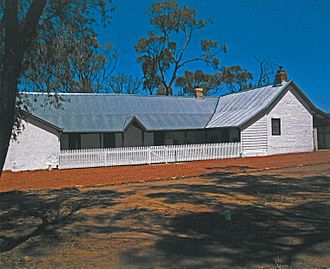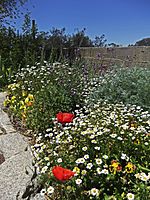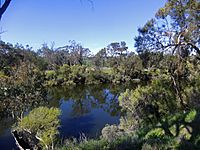Gwambygine Homestead facts for kids
Quick facts for kids Gwambygine Homestead |
|
|---|---|

Gwambygine Homestead, around 2012
|
|
| General information | |
| Type | Homestead |
| Location | York, Western Australia |
| Coordinates | 31°58′51.34″S 116°48′21.59″E / 31.9809278°S 116.8059972°E |
| Designated | 16 May 2008 |
| Reference no. | 14880 |
Gwambygine Homestead is one of the oldest buildings from the early days of European settlement that is still standing in Western Australia. It was continuously lived in until 1998, making it famous for being the oldest house in the state with people living in it all the time.
Contents
A Look at Early History
First People and the Land
Indigenous people, especially the Noongar (Ballardong) people, have used the Gwambygine area and its important pool for thousands of years. This land near York was first explored by Europeans in 1830. A large Aboriginal gathering, called a corroboree, was recorded here in 1841. The Avon River and the pool are still very important culturally to Aboriginal people today.
The First European Owners
The Gwambygine Estate was one of the first large pieces of land given out in the new British Colony of Swan River. This colony was started in 1829 because the British worried that the French might claim the western part of Australia.
Reverend John Burdett Wittenoom (1788–1855) was the main church leader for the new colony. He came to Australia in 1829 with his sister and four sons, hoping to start a new life and for his sons to own land.
In 1830, Reverend Wittenoom received a large land grant along the Avon River. The name Gwambygine comes from the local Noongar name for the deep, permanent pool in the Avon River. This pool was very important and helped decide where the homestead would be built. The local Aboriginal people called the area around the pool Gwarbanginning, which means 'a good place to stay'. This name proved true for the three main families who lived there: the Wittenooms, Hicks, and Cliftons.
Building the Homestead
In 1836, Reverend Wittenoom's teenage sons, along with an early settler named Thomas Carter, began building the first parts of the house. They built the house using mud, a method Carter had seen in England. Carter also helped farm wheat and sheep on the property.
Reverend Wittenoom was a very respected clergyman and a key member of the early colony. He helped establish St. George's Church in Perth, which was finished in 1845.
After Reverend Wittenoom passed away in 1855, the Gwambygine Estate was divided among his family. His youngest son, Charles Wittenoom, received the part with the Homestead. Sadly, Charles's wife and baby son died in 1861. After this, Charles leased Gwambygine to Joseph Hicks senior, who managed the farm and worked as a blacksmith. The Hicks family also operated a blacksmith shop on the property.
When Charles Wittenoom died in 1866, the property went to his sons, Frank and Edward. The Hicks family continued to live and work at the homestead for many years.
The Twentieth Century and Beyond
Changes in Ownership
In 1901, the Western Australian Government bought parts of Gwambygine for railway purposes. The land was then divided into smaller blocks.
Later, in 1923, Joseph Hicks junior bought back some of these blocks, including the land around the Homestead. He put the titles in his unmarried daughter Henrietta Maria Hicks's name.
The Clifton family also became involved with Gwambygine. In 1899, Joseph Hicks junior's other daughter, Florence, married Claude Robert Henry Clifton. Their son, Brian Merton Clifton (known as Merton), started working on the Gwambygine property in 1925. Merton and his wife, Gwenyth, rented the homestead from his aunt Henrietta and made changes to it to suit their needs.
When Henrietta Hicks died in 1952, the Gwambygine property passed to Merton Clifton. He continued to live there until he passed away in 1998. After his death, Gwambygine Homestead was closed and has been empty since.
The main part of the house was built using rammed earth, which is a mix of clay, sand, and straw. Later parts, like the chimneys, were made from fired bricks. The walls are about 300 mm thick. Today, Merton Clifton's daughter, Mrs. Margaret (Maggie) Venerys, owns the property.
Bringing the Homestead Back to Life
The Need for Restoration
After Merton Clifton's death in 1998, the building started to fall apart. Termites and water caused a lot of damage. In 2004, a historian named Pamela Statham-Drew and a Wittenoom family descendant, Jacqueline O'Brien, became interested in restoring the homestead.
In 2009, Pamela Statham-Drew asked the River Conservation Society of York for help to get money to fix the building. They found out about government funding for heritage projects that were ready to start. Thanks to earlier studies, a plan for restoration was already in place.
The Restoration Project
Pamela, along with her husband Nick, and Tony Clack from the River Conservation Society, applied for funds. They received $100,000 from the Federal Government and another $30,000 from the Western Australian Heritage Council.
Restoration work began in late 2009. First, they removed seven termite nests! Then, they replaced the entire roof. They kept the old wooden shingles underneath but put new corrugated iron over them to stop leaks. Workers also repaired the timber and carefully fixed the damaged mud walls and brickwork. They then painted the walls with a special whitewash.
A party was held in December 2010 to celebrate the work being finished. However, a huge storm in January 2011 damaged the kitchen roof and a newly completed out-house. Much of the original shingle roof was lost. It took the rest of that year to repair the new damage.
Visiting Gwambygine Homestead
The group that helped restore Gwambygine promised the government they would open the house to the public. So, you can visit Gwambygine Homestead from April to October on the second Saturday of each month, or by making an appointment. Visitors help the society keep this important piece of Western Australian history alive.
About the Building Itself
Gwambygine Homestead is closely connected to the permanent Gwambygine Pool in the Avon River, which flows past the property. The homestead is a typical old rural farmhouse. It has single rooms that open onto verandas on both sides. These verandas provided shade and protection from the weather. They also allowed access to the different rooms like the sitting room, bedrooms, kitchen, and storerooms.
The house has a high-pitched roof and shady verandas, which was common for early Western Australian farmhouses. It also shows how the house was extended over time to make more space for growing families.
Built in 1836, the house shows how early buildings were made. The mud walls were built from clay, sand, and straw found on the property. The roof frame was made from rough timber cut nearby. The original roof was covered with grasstree leaves, then later with wooden shingles. In the late 1800s, corrugated iron was added over the shingles to protect against the weather.
Bricks made by convict laborers were used later for chimneys and wall repairs. Fireplaces provided heat in the rooms, and most are still there today. In the 1900s, concrete replaced the original wooden floors, which were laid directly on the ground. These concrete floors made a problem called rising damp worse, which damages the bottom part of the mud walls.
Today, the Gwambygine property is known as Lot 36, No. 5561 Southern Highway. It covers about 36.77 hectares (90.86 acres) and includes Gwambygine Homestead. It is owned by Margaret (Maggie) Venerys, who is Merton Clifton's daughter.
Some parts of the original Gwambygine Farm have not survived over time. These include a large shed, a timber building, an air raid shelter, duck yards, and parts of the orchard. The sheep pens and pigsty were removed during restoration because they were full of termites. The old tennis court, which was made of rammed anthill, is now an open space.
Other important places linked to Gwambygine Farm include the nearby Hicks Siding on the railway, Hicks Siding School, and the District Hall. These are now only historic sites. The Clifton family's Cave Hill House and Millbrook also survive as important early buildings in the area.
Natural features like Cave Hill, Gwambygine Hill, and Sugarloaf Hill were very important to the Gwambygine community. Blackjack Dam, many waterholes, a quarry, and caves at Cave Hill were all important for farming and are still relevant historic sites today.



